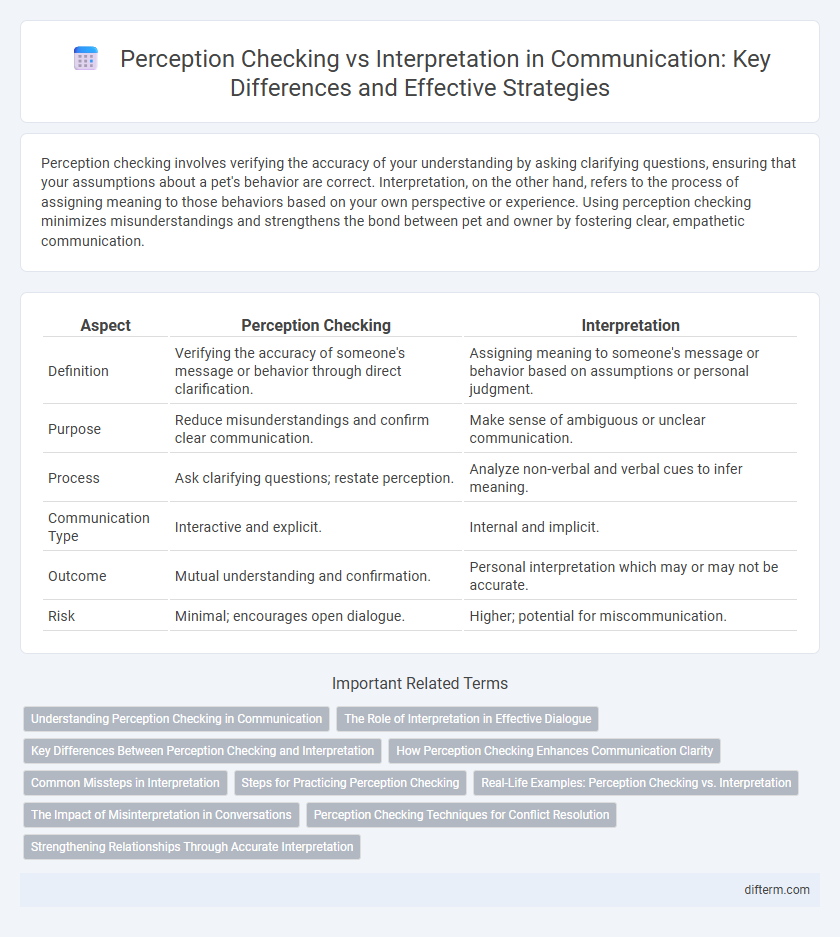Perception checking involves verifying the accuracy of your understanding by asking clarifying questions, ensuring that your assumptions about a pet's behavior are correct. Interpretation, on the other hand, refers to the process of assigning meaning to those behaviors based on your own perspective or experience. Using perception checking minimizes misunderstandings and strengthens the bond between pet and owner by fostering clear, empathetic communication.
Table of Comparison
| Aspect | Perception Checking | Interpretation |
|---|---|---|
| Definition | Verifying the accuracy of someone's message or behavior through direct clarification. | Assigning meaning to someone's message or behavior based on assumptions or personal judgment. |
| Purpose | Reduce misunderstandings and confirm clear communication. | Make sense of ambiguous or unclear communication. |
| Process | Ask clarifying questions; restate perception. | Analyze non-verbal and verbal cues to infer meaning. |
| Communication Type | Interactive and explicit. | Internal and implicit. |
| Outcome | Mutual understanding and confirmation. | Personal interpretation which may or may not be accurate. |
| Risk | Minimal; encourages open dialogue. | Higher; potential for miscommunication. |
Understanding Perception Checking in Communication
Perception checking in communication involves clarifying and verifying the accuracy of understanding someone's message before making assumptions, which reduces misunderstandings and misinterpretations. It consists of describing the behavior observed, offering two possible interpretations, and requesting clarification from the speaker. This technique enhances effective communication by promoting empathy and ensuring both parties share a mutual understanding.
The Role of Interpretation in Effective Dialogue
Interpretation plays a critical role in effective dialogue by enabling individuals to assign meaning to messages based on context, tone, and nonverbal cues, which helps clarify intentions and reduce misunderstandings. Unlike perception checking, which involves confirming one's understanding with the speaker, interpretation requires analyzing and synthesizing information to form accurate conclusions. Mastering interpretation skills enhances communication accuracy, fosters empathy, and supports collaborative problem-solving.
Key Differences Between Perception Checking and Interpretation
Perception checking involves verifying the accuracy of others' emotions or messages by seeking clarification through specific questions or restating observations, reducing misunderstandings in communication. Interpretation is the process of assigning meaning to messages or behaviors based on personal experiences, biases, and context, which can lead to subjective conclusions. Key differences include perception checking's reliance on feedback for accuracy, while interpretation depends on individual judgment without immediate validation.
How Perception Checking Enhances Communication Clarity
Perception checking reduces misunderstandings by verifying the accuracy of one's interpretations before responding, fostering clearer communication between parties. This process involves observing behavior, proposing multiple interpretations, and requesting confirmation, which minimizes assumptions and potential conflicts. Enhanced clarity through perception checking leads to more effective interpersonal interactions and stronger relationships.
Common Missteps in Interpretation
Common missteps in interpretation often stem from assumptions and cultural biases that distort the sender's intended message. Failing to engage in perception checking can lead to misunderstandings, as individuals may interpret nonverbal cues and ambiguous language inaccurately. Accurate communication requires verifying interpretations by asking clarifying questions to avoid miscommunication and conflict.
Steps for Practicing Perception Checking
Perception checking involves three key steps: describing the observed behavior objectively, offering two possible interpretations for the behavior, and requesting clarification from the other person to confirm accuracy. This method reduces misunderstandings by focusing on specific, observable facts rather than assumptions. Practicing perception checking enhances communication clarity and fosters mutual understanding in interpersonal interactions.
Real-Life Examples: Perception Checking vs. Interpretation
Perception checking involves verifying the accuracy of what you observe before drawing conclusions, such as asking a coworker if they seemed upset rather than assuming their mood. Interpretation often leads to misunderstandings when one person assumes negative intent behind another's behavior without confirmation. For instance, perception checking prevents conflicts in workplace communication by encouraging open dialogue, while unchecked interpretation can escalate tensions based on inaccurate assumptions.
The Impact of Misinterpretation in Conversations
Misinterpretation in conversations often arises from inaccurate perception checking, leading to misunderstandings and conflict. Clear and accurate perception checking minimizes assumptions and ensures that messages are correctly comprehended, enhancing communication effectiveness. Failure to verify interpretations can distort intent, damaging trust and collaboration in both personal and professional interactions.
Perception Checking Techniques for Conflict Resolution
Perception checking enhances conflict resolution by clarifying ambiguous messages and reducing misunderstandings through three key steps: describing the behavior, offering two possible interpretations, and requesting clarification. This technique prevents assumptions, fosters empathy, and promotes open dialogue by encouraging parties to verify perceptions before reacting. Employing perception checking leads to more accurate communication and strengthens trust between conflicting individuals.
Strengthening Relationships Through Accurate Interpretation
Perception checking enhances relationship strength by clarifying others' messages before reacting, reducing misunderstandings and fostering trust. Accurate interpretation relies on verifying feelings and meanings through open, respectful dialogue, which promotes empathy and deeper connection. Employing perception checking as a communication tool minimizes assumptions and cultivates a shared understanding essential for lasting relationships.
perception checking vs interpretation Infographic

 difterm.com
difterm.com